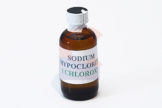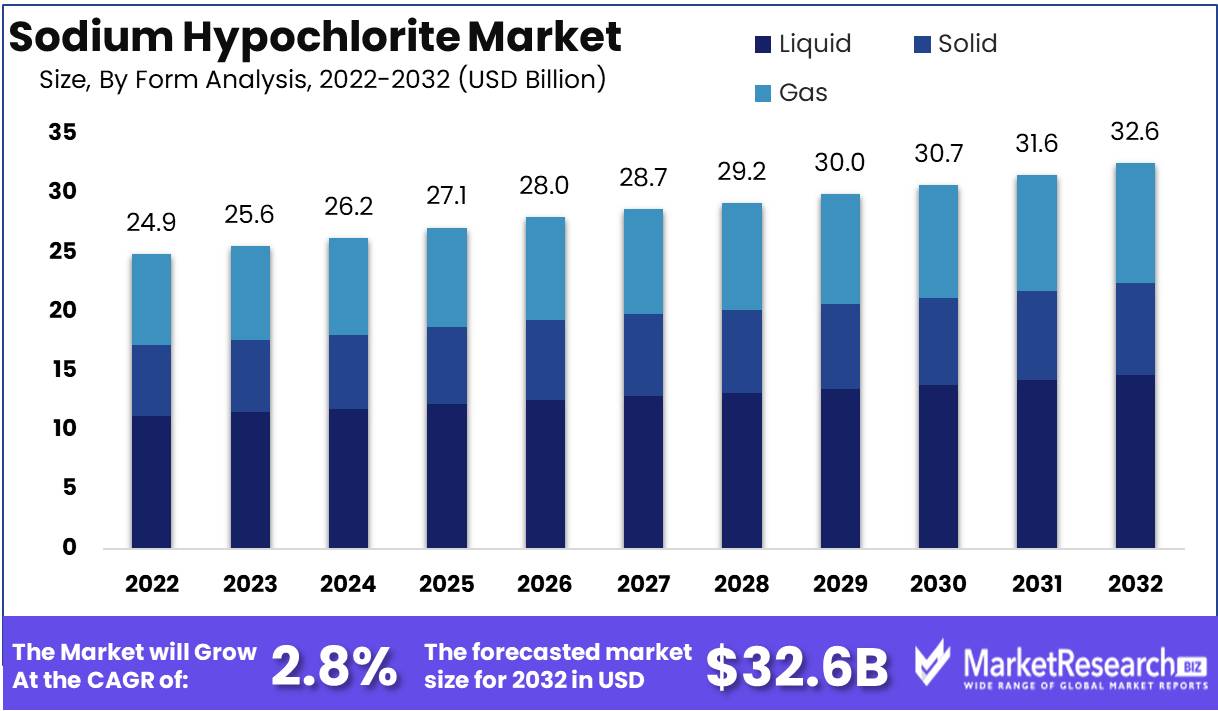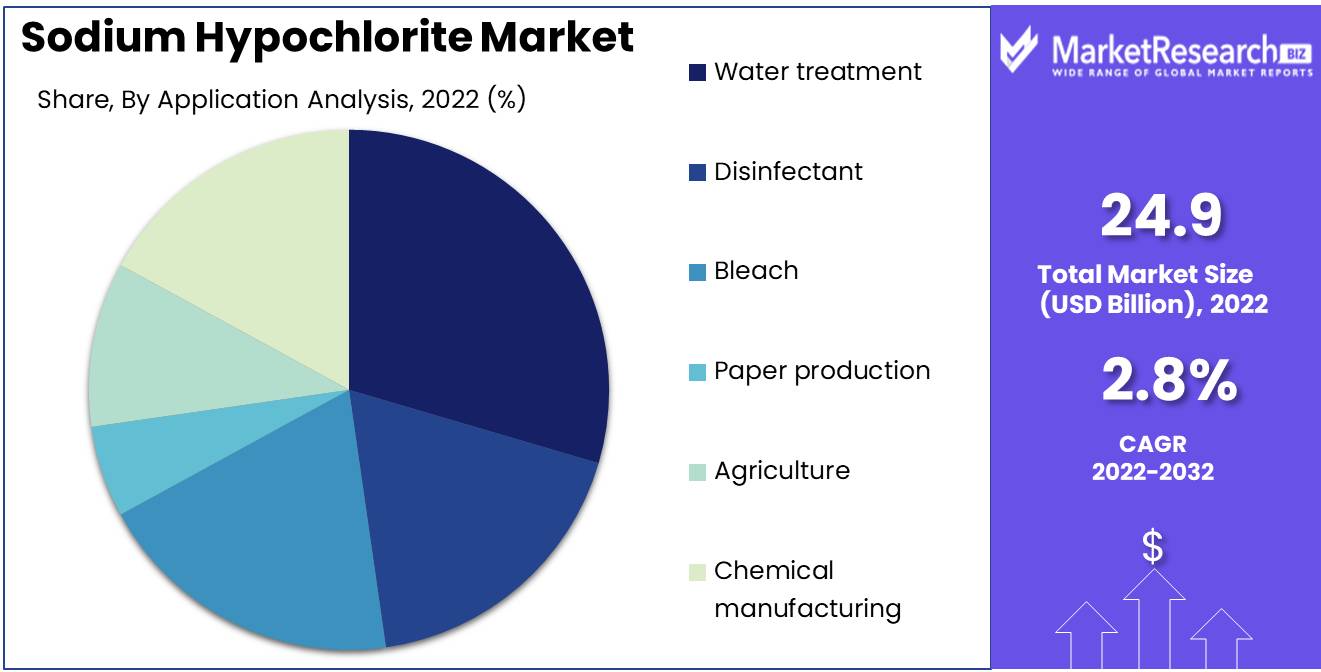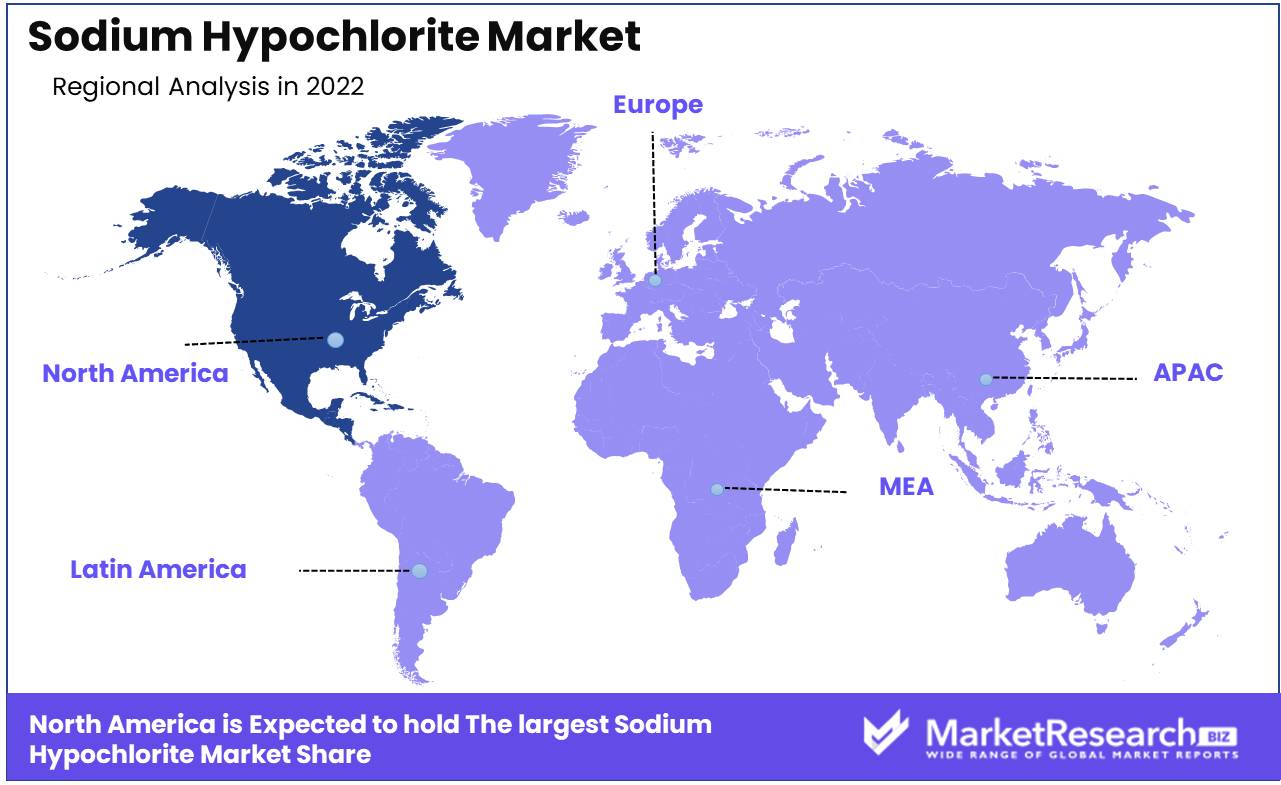
Sodium Hypochlorite Market By Application Analysis (Water treatment, Disinfectant, Bleach, Paper production, Other), By Form Analysis (Liquid, Solid, Gas), By Region And Companies - Industry Segment Outlook, Market Assessment, Competition Scenario, Trends, And Forecast 2023-2032
-
6302
-
May 2023
-
172
-
-
This report was compiled by Shreyas Rokade Shreyas Rokade is a seasoned Research Analyst with CMFE, bringing extensive expertise in market research and consulting, with a strong background in Chemical Engineering. Correspondence Team Lead-CMFE Linkedin | Detailed Market research Methodology Our methodology involves a mix of primary research, including interviews with leading mental health experts, and secondary research from reputable medical journals and databases. View Detailed Methodology Page
-
Quick Navigation
Report Overview
The Sodium Hypochlorite Market size is expected to be worth around USD 32.6 Bn by 2032 from USD 24.9 Bn in 2022, growing at a CAGR of 2.8% during the forecast period from 2023 to 2032.
Sodium hypochlorite, an inorganic compound that deftly serves as both a disinfectant and a bleaching agent, enjoys unwavering preeminence. It is widely used in the healthcare industry to sterilize medical equipment and in the water treatment industry to purify drinking water. It also aids in the preservation of consumables in the food industry and has unwavering significance in household cleaning products.

The primary objective underlying the sodium hypochlorite market is the provision of safe and effective disinfectants and bleaching agents to a variety of industries. The mechanism involves the release of chlorine gas by sodium hypochlorite, which immediately undergoes a symbiotic reaction with water to produce hypochlorous acid. This acid acts as a formidable oxidizing agent, decimating pathogenic bacteria, viruses, and various other harmful microorganisms with remarkable efficiency.
Given its numerous applications in numerous industries, sodium hypochlorite is unquestionably indispensable. Utilized extensively in the healthcare sector for the sterilization of medical equipment, the water treatment industry for the purification of potable water, the food industry as a viable sustainable food preservative, and even permeating household cleaning products, this substance is a model of efficacy and cost-effectiveness, satisfying the need for a hygienic and safe environment.
In recent years, the sodium hypochlorite market has been characterized by a proliferation of noteworthy innovations that have lent it an aura of vitality. The advent of on-site sodium hypochlorite generators, a cutting-edge innovation that enables facilities to produce their own sodium hypochlorite on-site, stands out among these developments. This revolutionary innovation eliminates the need to transport and store large quantities of sodium hypochlorite, thereby mitigating associated dangers.
The sodium hypochlorite market is poised for significant growth in the near future, with promising future prospects. The escalating demand for disinfectants and bleaching agents across numerous industries is driving this growth trend. The healthcare, water treatment, food, and household cleansing industries all contribute to the market's upward momentum.
Significant drivers of the sodium hypochlorite market include the escalating demand for disinfectants and bleaching agents in a variety of industries, the urgent need for effective and cost-effective methods to preserve a hygienic and safe environment, and the unprecedented development of on-site sodium hypochlorite generators, which is revolutionizing the industry landscape.
Driving factors
Demand Expansion Drives the Growth of the Sodium Hypochlorite Market
Due to a number of factors, including the rising demand for disinfectants and bleaching agents in various industries, the sodium hypochlorite market is expected to experience growth. Due to its high effectiveness against hazardous pathogens, sodium hypochlorite is utilized in the food and beverage industry, the healthcare industry, and in homes. In addition, the increasing use of sodium hypochlorite in water treatment applications and the growing awareness of the importance of hygiene and sanitation are driving the market growth.
Governmental Regulations Stimulate the Sodium Hypochlorite Market
Government regulations requiring the use of sodium hypochlorite in particular industries, such as water treatment, are expected to further stimulate market growth. It is expected that the expansion of the food and beverage industry, along with the expansion of the healthcare sector and increased demand for disinfection products, will positively impact market growth. The demand for pulp and paper products that use sodium hypochlorite as a bleaching agent is expected to contribute to the growth of the market as population and urbanization increase.
Potential Regulatory Alterations Impact the Sodium Hypochlorite Market.
There are currently no significant alterations to the regulations that may affect the sodium hypochlorite market. In the future, stringent regulations may be imposed on the use and disposal of sodium hypochlorite as environmental concerns increase. Electrochemical oxidation and other emerging technologies have the potential to displace sodium hypochlorite as a disinfectant, which could have a negative impact on market growth.
Emerging Antibacterial Products Disrupt Sodium Hypochlorite Market
The emergence of novel disinfectant products poses the greatest potential threat to the competitive environment of the sodium hypochlorite market. As consumers become more aware of sodium hypochlorite's side effects and environmental impact, they may transition to alternative products, which could affect the market share of sodium hypochlorite manufacturers.
Shift Toward Biodegradable Disinfectants Influences Sodium Hypochlorite Market
As consumers become more health- and environmentally conscious, there is the potential for a shift toward bio-based and natural disinfectants, which could impact the growth of the sodium hypochlorite market. Additionally, changes in consumer behavior, such as a preference for eco-friendly packaging in the food and beverage industry, could impact the market's future growth.
Restraining Factors
Sodium Hypochlorite Health Risks
In healthcare, water treatment, and food processing, sodium hypochlorite market is a disinfectant and bleaching agent. If not treated appropriately, sodium hypochlorite can cause major health risks. Concentrated sodium hypochlorite can burn skin, eyes, and lungs. Sodium hypochlorite reacts with other substances to create chlorine gas. These risks have led to increased regulation and the use of less hazardous disinfectants such as hydrogen peroxide and chlorine dioxide.
Safer Sodium Hypochlorite Alternatives
Hydrogen peroxide and chlorine dioxide are effective sodium hypochlorite alternatives. These options are safer, produce less waste, and have shorter contact durations. Hydrogen peroxide is a strong oxidizing agent used as a disinfectant and bleach. The vapor or solution has wide antibacterial action. To disinfect water, surfaces, and equipment, chlorine dioxide, a potent oxidizing agent, is utilized. It's effective against bacteria, fungi, and viruses.
Sodium Hypochlorite Prices Change
Raw ingredients like chlorine and caustic soda affect sodium hypochlorite market prices. Electrolyzing these materials produces sodium hypochlorite. Due to supply chain problems, rising demand from other industries, and regulatory changes, chlorine prices have increased in recent years. This has led to increasing sodium hypochlorite production prices and increased demand to discover alternate chlorine sources.
Sodium Hypochlorite Disposal Environmental Issues
Environmental restrictions govern sodium hypochlorite disposal. Improper disposal can lead to soil and water contamination, harming humans and the environment. Neutralizing sodium hypochlorite before disposal is complicated and expensive. These requirements have led to increased interest in sustainable disinfectant and disinfection solutions.
Sodium Hypochlorite Problems
Sodium hypochlorite market handling and application demand specialist expertise and training. Companies must provide thorough employee training to utilize sodium hypochlorite safely and effectively. Companies in this market face hurdles due to a shortage of competent workers and expensive training costs. Skilled worker turnover can lead to production disruptions and lower efficiency.
Application Analysis
With numerous divisions serving various applications, the sodium hypochlorite market is one that is very competitive. Due to its diverse applications, including the disinfection of drinking water, sanitation, and wastewater treatment, the water treatment segment dominates the market. The growing demand for clean, safe drinking water in both developed and developing countries is driving the Water treatment Segment's demand.
The global economic development in rising economies like India, China, and Brazil is driving the Water treatment Segment adoption. Due to population growth, industrialization, and urbanization, these countries have significant issues in terms of water management. Due to this, these countries have an increasing demand for effective water treatment techniques. The sodium hypochlorite market is being driven primarily by the development of new technologies and increasing investments in the water treatment sector.
Driving consumer behavior toward the Water treatment Segment is the increasing demand for safe and clean water. Products that are effective and efficient at disinfecting water are more inclined to be purchased by customers. Additionally, consumers are more prepared to pay more for water treatment options as they become more conscious of the negative effects of water pollution on their health.
The Water Treatment Segment of the Sodium Hypochlorite Market is anticipated to register the quickest growth rate over the upcoming years, owing to the increasing demand for safe and clean water globally. Water quality is declining as a result of the growing population, urbanization, and industrialization, which has increased demand for an efficient and cost-effective water treatment solution. The development of new technologies and increasing investments in the water treatment industry are additional factors serving as major catalysts for the growth of this segment.

Form Analysis
Owing to its ease of use and efficacy in disinfection, the Liquid Segment dominates the sodium hypochlorite market.
Due to its ease of use and efficacy in disinfection, the economic growth of emerging economies is driving the adoption of the Liquid Segment. There is a growing need for effective disinfection solutions since nations like India and China have significant issues in terms of hygiene and sanitation.
Driving consumer behavior toward the Liquid Segment is the increasing demand for simple-to-use and effective disinfection products. Products with high efficacy in disinfection are more likely to be purchased by consumers. The Liquid Segment is also driving consumer behavior due to the increasing awareness of the significance of hygiene and cleanliness.
Due to its ease of use and efficacy in disinfection, the Liquid Segment of the Sodium Hypochlorite Market is anticipated to register the fastest growth rate in the approaching years. The development of new technologies and increasing investments in the disinfection industry are serving as the main forces behind the growth of this segment. The demand for the Liquid Segment is also being fueled by the growing demand for simple, effective, and easy-to-use disinfection solutions.
Key Market Segments
By Application Analysis
- Water treatment
- Disinfectant
- Bleach
- Paper production
- Agriculture
- Chemical manufacturing
By Form Analysis
- Liquid
- Solid
- Gas
Growth Opportunity
Healthcare Expansion Fuels the Growth of the Sodium Hypochlorite Market
Healthcare Sector Growth in Emerging Economies, Growing Need for Sodium Hypochlorite in Water Treatment Applications, The Food and Beverage Industry Has a Growing Need for Disinfectants, Development of Eco-Friendly and Sustainable Sodium Hypochlorite Products, Increase in Demand for Pulp and Paper Products in the Asia Pacific Region.
Water Treatment Increases the Need for Sodium Hypochlorite
Bleach, commonly known as sodium hypochlorite, is a potent cleaning and disinfection substance used in a variety of settings. The growing prospects and market-shaping difficulties are driving the rising demand for sodium hypochlorite on a global scale.
Sodium Hypochlorite Demand is Driven by the Food Industry
One of the main factors influencing the market for sodium hypochlorite's growth potential is the development of the healthcare sector in emerging economies. In developing nations like India, China, and Brazil, demand for medical products, such as sterilizers and disinfectants, has dramatically expanded. The healthcare industry is expanding twice as quickly in low- and middle-income nations as it is in high-income ones, according to a World Bank analysis.
The Sodium Hypochlorite Market is Driven by Asia Pacific
Another important factor influencing the market's potential for growth is the need for sodium hypochlorite in water treatment applications. Drinking water and wastewater are disinfected with sodium hypochlorite, which aids in the eradication of potentially dangerous bacteria, viruses, and germs. The need for water treatment products and services is growing globally as a result of population increase and urbanization, which is boosting the market for sodium hypochlorite's potential growth.
Environmentally Friendly Sodium Hypochlorite Gains Ground
In order to guarantee that the general public has access to safe and high-quality food items, the food and beverage sector is crucial. The demand for sodium hypochlorite is being driven by the expanding need for disinfectants in the food and beverage sector. Food safety depends on sodium hypochlorite's ability to disinfect surfaces and stop the spread of dangerous germs and viruses.
Latest Trends
Modernized Production Drives the Sodium Hypochlorite Market
One of the main market trends that are shaping the sodium hypochlorite market is the adoption of advanced manufacturing technologies and processes. Manufacturers are investing in new technologies in order to increase production efficiency, decrease costs, and enhance product quality. Automation, robotics, and other advanced technologies are assisting manufacturers in producing high-quality sodium hypochlorite more quickly and consistently.
Demand for eco-friendly Sodium Hypochlorite Is Growing
The increasing demand for eco-friendly and sustainable products is another significant market trend that is shaping the sodium hypochlorite market. Customers are becoming more aware of the environmental impact of the products they use and are seeking environmentally beneficial and sustainable products. Because they are effective for cleaning and disinfecting while being environmentally friendly, sodium hypochlorite-based products are well-liked by customers.
Sodium Hypochlorite Prospers in the Oil and Gas Sector
Due to its superb oxidizing properties, the oil and gas industry is increasing its use of sodium hypochlorite. In the oil and gas industry, sodium hypochlorite is used for a variety of purposes, including cleaning and disinfecting water, purifying oil and gas, and treating oil accidents. The increasing prominence of sodium hypochlorite in the oil and gas industry drives the market demand for sodium hypochlorite of superior quality.
Sodium Hypochlorite Is Preferred By More People
Another significant market trend that is shaping the sodium hypochlorite market is the increasing popularity of sodium hypochlorite-based cleaning products in households. Due to their efficacy and affordability, sodium hypochlorite-based cleaning products are widely used in households for cleaning and disinfecting. Sodium hypochlorite-based cleaning products are becoming an even more popular option for customers due to the expanding trend of eco-friendly and sustainable products.
Private Labels Influence the Development of the Sodium Hypochlorite Market
The emergence of private-label brands and increased competition among market participants are also shaping the sodium hypochlorite market. Private label brands provide customers with an option that is more affordable without sacrificing quality. To remain competitive in the market, manufacturers are focusing on enhancing product quality, reducing costs, and increasing production efficiency in response to this trend.
Regional Analysis
The North American market is mature and its industrial foundation is well-established. High demand exists for sodium hypochlorite in water treatment and disinfection applications. Due to the increase in water pollution and population growth, the demand for sodium hypochlorite is expanding.
The North American sodium hypochlorite market is growing at a stable rate due to the demand for water treatment and disinfection applications. The market is driven by government regulations regarding water safety, a growing population, and an expanding industrial base.
The United States is one of the largest markets in North America for sodium hypochlorite. The demand for sodium hypochlorite for various applications is met by the country's well-developed industrial base. The demand for sodium hypochlorite in the United States is increasing due to the country's growing population and increased domestic, industrial, and agricultural water usage.
The sodium hypochlorite market in North America faces a number of obstacles that may impede its growth in the region. The exorbitant cost of production and transportation is one of the market's most significant obstacles. The high cost of raw materials utilized in the production of sodium hypochlorite impacts the overall production cost.
Regulations imposed by the government present another obstacle to the sodium hypochlorite market in North America. The government has established stringent regulations regarding the use of sodium hypochlorite in water treatment and disinfection applications. These regulations affect market growth because companies must comply with them in order to offer their products on the market.
In North America, the sodium hypochlorite market has a number of growth opportunities that may contribute to the market's expansion in the region. The expanding demand for sodium hypochlorite in the food and beverage industry is one of the most significant market opportunities. In the food and beverage industry, sodium hypochlorite is used to sanitize equipment and surfaces, which aids in maintaining quality standards.

Key Regions and Countries
North America
- US
- Canada
- Mexico
Western Europe
- Germany
- France
- The UK
- Spain
- Italy
- Portugal
- Ireland
- Austria
- Switzerland
- Benelux
- Nordic
- Rest of Western Europe
Eastern Europe
- Russia
- Poland
- The Czech Republic
- Greece
- Rest of Eastern Europe
APAC
- China
- Japan
- South Korea
- India
- Australia & New Zealand
- Indonesia
- Malaysia
- Philippines
- Singapore
- Thailand
- Vietnam
- Rest of APAC
Latin America
- Brazil
- Colombia
- Chile
- Argentina
- Costa Rica
- Rest of Latin America
Middle East & Africa
- Algeria
- Egypt
- Israel
- Kuwait
- Nigeria
- Saudi Arabia
- South Africa
- Turkey
- United Arab Emirates
- Rest of MEA
Key Players Analysis
In recent years, the sodium hypochlorite market has expanded rapidly due to the increasing demand for the chemical in applications such as water treatment, disinfection, and bleaching. Dow Chemical Company, Solvay SA, Akzo Nobel N.V., BASF SE, Occidental Petroleum Corporation, Arkema Group, Olin Corporation, and Tosoh Corporation are some of the key participants in the sodium hypochlorite market.
The Dow Chemical Company is well-known for its innovative technologies and high-quality products in the sodium hypochlorite market. Under the brand name HYPOX, the company offers an extensive selection of sodium hypochlorite products. It offers solutions of sodium hypochlorite in a variety of concentrations and forms, including liquid and solid.
Another significant player in the sodium hypochlorite market, Solvay SA operates in the chemicals and advanced materials industry. The company offers solutions of sodium hypochlorite under the brand name SOLVAY. The company's assortment of sodium hypochlorite products is widely employed in water treatment applications.
The Dutch multinational company Akzo Nobel N.V. operates in the specialty chemicals industry. Under the brand name EKA, the company offers a variety of sodium hypochlorite products. Its products are widely utilized in numerous applications, such as water treatment, bleaching, and disinfection.
Top Key Players in Sodium Hypochlorite Market
- Odyssey Manufacturing Co.
- AGC Inc.
- Sunbelt Chemical Corp
- Orica Watercare
- Shanghai Polymet Commodities Ltd.
- Solvay Chemicals, Inc.
- Akzo Nobel N.V.
- BASF SE
- Olin Corporation
- Arkema Inc.
- Dow Chemical Company
- Occidental Petroleum Corporation
- Tosoh Corporation
Recent Development
- In September 2020, Solvay, a significant chemical company announced the expansion of its sodium hypochlorite production capacity in Europe.
- In July 2020, Occidental Chemical Corporation announced the acquisition of INEOS ChlorVinyls' North American chlor alkali business, which included sodium hypochlorite production. This acquisition was a strategic move to broaden Occidental's product offerings and market presence.
- In March 2020, Olin Corporation announced the expansion of its sodium hypochlorite production capacity in the United States.
- In October 2019, The global chemical company Kemira announced the expansion of its sodium hypochlorite production capacity in Finland.
Report Scope:
Report Features Description Market Value (2022) USD 24.9 Bn Forecast Revenue (2032) USD 32.6 Bn CAGR (2023-2032) 2.8% Base Year for Estimation 2022 Historic Period 2016-2022 Forecast Period 2023-2032 Report Coverage Revenue Forecast, Market Dynamics, COVID-19 Impact, Competitive Landscape, Recent Developments Segments Covered By Application Analysis (Water treatment, Disinfectant, Bleach, Paper production, Agriculture, Chemical manufacturing), By Form Analysis (Liquid, Solid, Gas) Regional Analysis North America – The US, Canada, & Mexico; Western Europe – Germany, France, The UK, Spain, Italy, Portugal, Ireland, Austria, Switzerland, Benelux, Nordic, & Rest of Western Europe; Eastern Europe – Russia, Poland, The Czech Republic, Greece, & Rest of Eastern Europe; APAC – China, Japan, South Korea, India, Australia & New Zealand, Indonesia, Malaysia, Philippines, Singapore, Thailand, Vietnam, & Rest of APAC; Latin America – Brazil, Colombia, Chile, Argentina, Costa Rica, & Rest of Latin America; Middle East & Africa – Algeria, Egypt, Israel, Kuwait, Nigeria, Saudi Arabia, South Africa, Turkey, United Arab Emirates, & Rest of MEA Competitive Landscape Odyssey Manufacturing Co., AGC Inc., Sunbelt Chemical Corp, Orica Watercare, Shanghai Polymet Commodities Ltd., Solvay Chemicals, Inc., Akzo Nobel N.V., BASF SE, Olin Corporation, Arkema Inc., Dow Chemical Company, Occidental Petroleum Corporation, Tosoh Corporation Customization Scope Customization for segments, region/country-level will be provided. Moreover, additional customization can be done based on the requirements. Purchase Options We have three licenses to opt for: Single User License, Multi-User License (Up to 5 Users), Corporate Use License (Unlimited User and Printable PDF) -
-
- Odyssey Manufacturing Co.
- AGC Inc.
- Sunbelt Chemical Corp
- Orica Watercare
- Shanghai Polymet Commodities Ltd.
- Solvay Chemicals, Inc.
- Akzo Nobel N.V.
- BASF SE
- Olin Corporation
- Arkema Inc.
- Dow Chemical Company
- Occidental Petroleum Corporation
- Tosoh Corporation




